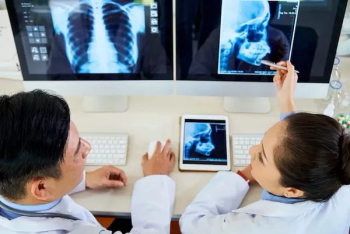
New Study Suggests MR Spectroscopy May Detect Brain Changes Linked to Disability in Multiple Sclerosis
Researchers found the use of magnetic resonance spectroscopic imaging revealed pathologic evidence of multiple sclerosis that is not evident on T1 or T2-weighted MRI.
Emerging research shows that magnetic resonance spectroscopic imaging (MRSI) may have advantages over morphologic magnetic resonance imaging (MRI) in identifying subtle pathology in normal-appearing white matter (NAWM) and cortical gray matter (CGM) associated with multiple sclerosis (MS).
The prospective study, recently published in
Noting that previous studies have cited elevated myo-inositol as a consistent finding in people with MS, the study authors said the use of single-voxel MRSI in these studies prevented researchers from determining whether this finding is pervasive in the NAWM. In contrast, the authors explained that the use of 7.0-T free-induction decay MRSI with 2x2 mm in-plane spatial resolution facilitated visualization of “focal and widespread pathologic manifestations” in NAWM, CGM and white matter lesions (WML).
“Our approach with an approximately 2x2 mm nominal voxel size and full in-section brain coverage not only improves the characterization of the WML, but also eliminates unwanted bias in the measurement of metabolic markers in the NAWM and, additionally, allows the visualization of this pathologic finding for the first time,” wrote Wolfgang Bogner, PhD, who is affiliated with the Department of Biomedical Imaging and Image-guided Therapy at the Medical University of Vienna in Austria, and colleagues. “ … Our results confirm that NAWM NAA/TCr is significantly reduced in participants with disability, and that axonal pathologic manifestations appear early, before the conversion into progressive MS.”
In an
“It is suggested that 7.0-T (MRSI) measurements may reflect the presence of mild or early cortical atrophy in patients, which is believed to be one of the important factors governing cognitive decline and long-term outcome,” wrote Dr. Barker, who has performed research on the use of MRSI and MRI for more than 30 years. “ … It is also suggested that 7.0-T (MRSI) may have a role in the early diagnosis of MS.”
The study authors conceded limitations to the study, including the lack of assessing whether spinal cord lesions were a contributing factor to neurologic disability as well as a limited MRSI protocol of obtaining one, two-dimensional 8 mm section. They also noted that due to unknown relaxation times and water content in lesions, they did not obtain absolute quantification of metabolite concentrations.
Newsletter
Stay at the forefront of radiology with the Diagnostic Imaging newsletter, delivering the latest news, clinical insights, and imaging advancements for today’s radiologists.




